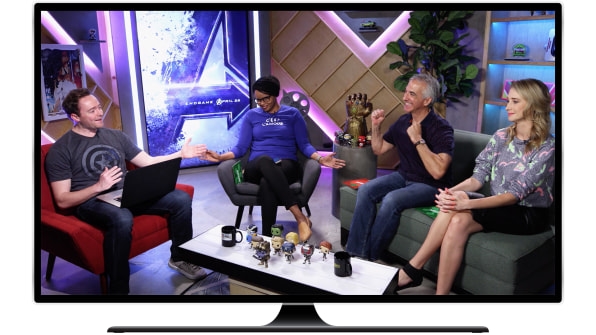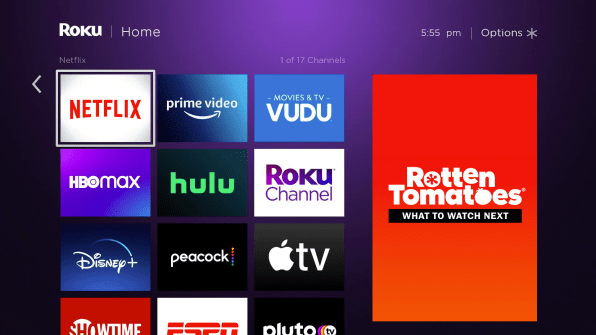Rotten Tomatoes wants to be more than a score. Inside its ambition to be a streaming destination
Ever since Rotten Tomatoes was dreamt up in 1998 by three Asian-American University of California at Berkeley undergrads who initially built the website to collect old reviews of Jackie Chan movies, it has been synonymous with its scores. The famed “Tomatometer” averages reviews from professional critics and slaps a movie or TV show with either a “fresh” rating—when 60% or more of the reviews are positive—or a “rotten” one. The results are visually conveyed, appropriately enough, with either a bright red tomato or a green splat.
There’s also an “audience score,” which is a tally of what Rotten Tomatoes users think of what they’ve watched. Mostly positive reviews (again, over 60%) result in an image of a full popcorn bucket. Mostly bad reviews: a tipped-over bucket.
But Sandro Corsaro, SVP and chief creative officer at Rotten Tomatoes, wants people to think of those scores as “the beginning discussion point,” he said recently. “They’re the opening line, so to speak.” In other words, sure, go to Rotten Tomatoes to see whether a movie or show is worth checking out. But then stay to be entertained by a nonstop barrage of content, and, ultimately, enter into a “lifestyle brand,” as Corsaro puts it, for passionate movie fans.
To this end, the company is launching a new, Rotten Tomatoes Channel on Roku on Tuesday. The ad-supported service will soon arrive on Peacock (Fandango, which acquired Rotten Tomatoes in 2016, is also owned by NBC Universal) and then roll out to other streaming platforms, including XUMO TV.
Corsaro, a former Disney Interactive creative director, likens the channel to MTV in the 1980’s. “If you think about the era before Jersey Shore, before The Real World—the way MTV was,” he says. “They packed in these awesome music videos and ultimately had blocks of content.”

These blocks will be comprised of shows and videos—including ten new, original series—for every level of movie geek and cinephile. There’s Versus, a show that uses box-office figures, the Tomatometer, and other data sources to settle important debates such as, “Who’s the best Chris? Chris Evans or Chris Pine?,” says Corsaro. In another episode, DeNiro and Pacino are pitted against one another. In Name the Review, celebs such as Brie Larson and Samuel L. Jackson read each other reviews of blockbuster movies they’ve starred in. The other actor has to guess which movie is being discussed. “It creates a lot of comedy and fun and dynamics,” says Corsaro. “It’s a different way to look at a junket. Rather than sitting down and saying, ‘Tell us what was exciting about making movie X, Y, and Z.’”
There are also more straightforward titles such as Countdown, which takes a category—e.g. best Tom Cruise movies—and ranks the entries, as well as Trailers Reloaded, a cornucopia of movie trailers that date back to the sixties.
The goal is for this content to “spark something within someone to say, ‘Oh my God. I never saw Get Shorty. I love John Travolta,” Corsaro says. “Or, ‘Wow, these are the top-10 horror movies. People get sparked in different ways . . . . We’re super hopeful that this is kind of going to be the beginning of the beginning for us around linear content.”
Although these originals are the beginning of TV-style viewing around the Rotten Tomatoes brand, the channel is just the latest step in the company’s evolution from a fanboy website into a full-fledged media business that publishes books (Rotten Movies We Love came out in 2019 and another will be published this fall), produces podcasts, and churns out original content and videos on its many social-media platforms. Due to the pandemic, which kept people strapped to their couches, and the growing clutter of TV shows and movies to choose from, unique visits to Rotten Tomatoes’ editorial content was up 147 percent in the first quarter of 2021 compared to the first quarter of 2020.

In 2018, Rotten Tomatoes unveiled a more polished logo that is “able to hang next to a Twitter or Instagram or Netflix,” Corsaro says. “We wanted it to be part of that. Not something that was a remnant from the 90’s.” Indeed, over the past few years, Corsaro and his team have been working to broaden the Rotten Tomatoes audience while still staying true to its core tenets of credibility and community. One unique aspect to the company is the fact that it does not rely on an algorithm to crunch data and spit out a review score. Rather, the company employs a team—of actual humans!—that pore over thousands of reviews every day, reading and even debating them before settling on a score, a practice that inspires huge brand trust in the company. It also introduced a Verified Audience Score that seeks to authenticate scores submitted by people who bought movie tickets through Fandango.
These systems remain intact. But in an effort to reach beyond the fanboy crowd, as well as better reflect the world we live in, the company expanded its critics’ community, adding hundreds of new voices, many of whom are from underrepresented and minority groups. The pool also includes many more freelance, digital, and podcast critics. “Who’s in the context of talking about these movies?” Corsaro says rhetorically. “It’s not always going to be two guys like in baseball hats. It’s important to have different points of view.”
Today, Rotten Tomatoes’ audience is far more evenly split between men and women, Corsaro says, and the site is as much about learning about the new Marvel title as about an Oscar-nominated foreign-language film such as Minari. “We love fanboys, but there’s a way bigger group than just those folks out there,” Corsaro says. “I love superhero movies. I’ve seen these guys flying around in capes—I get it. But there’s a whole broader spectrum out there, and we want to service all fans.”
The ultimate goal is to create an ongoing discussion and series of products to draw consumers into a cozy loop that’s far broader and more ambitious than simply being a tool that helps you decide which movies to watch. Corsaro cites Red Bull, the energy drink slash entertainment brand, as an inspiration.
“How do most people use Red Bull?,” he asks. “They drink it; it gives you wings. But there’s also a sub-segment that looks at it and drinks it because of the guy jumping from the moon, and they want to be involved in that.” (In 2012 Red Bull sponsored skydiver Felix Baumgartner’s supersonic jump and streamed it live on a webcast.)
Indeed, Corsaro says branded content is likely in the company’s future. Among other longer-term goals. When asked where he sees Rotten Tomatoes in ten or 15 years’ time, Corsaro laughs. “We want to be on the moon with Elon.”
(61)



